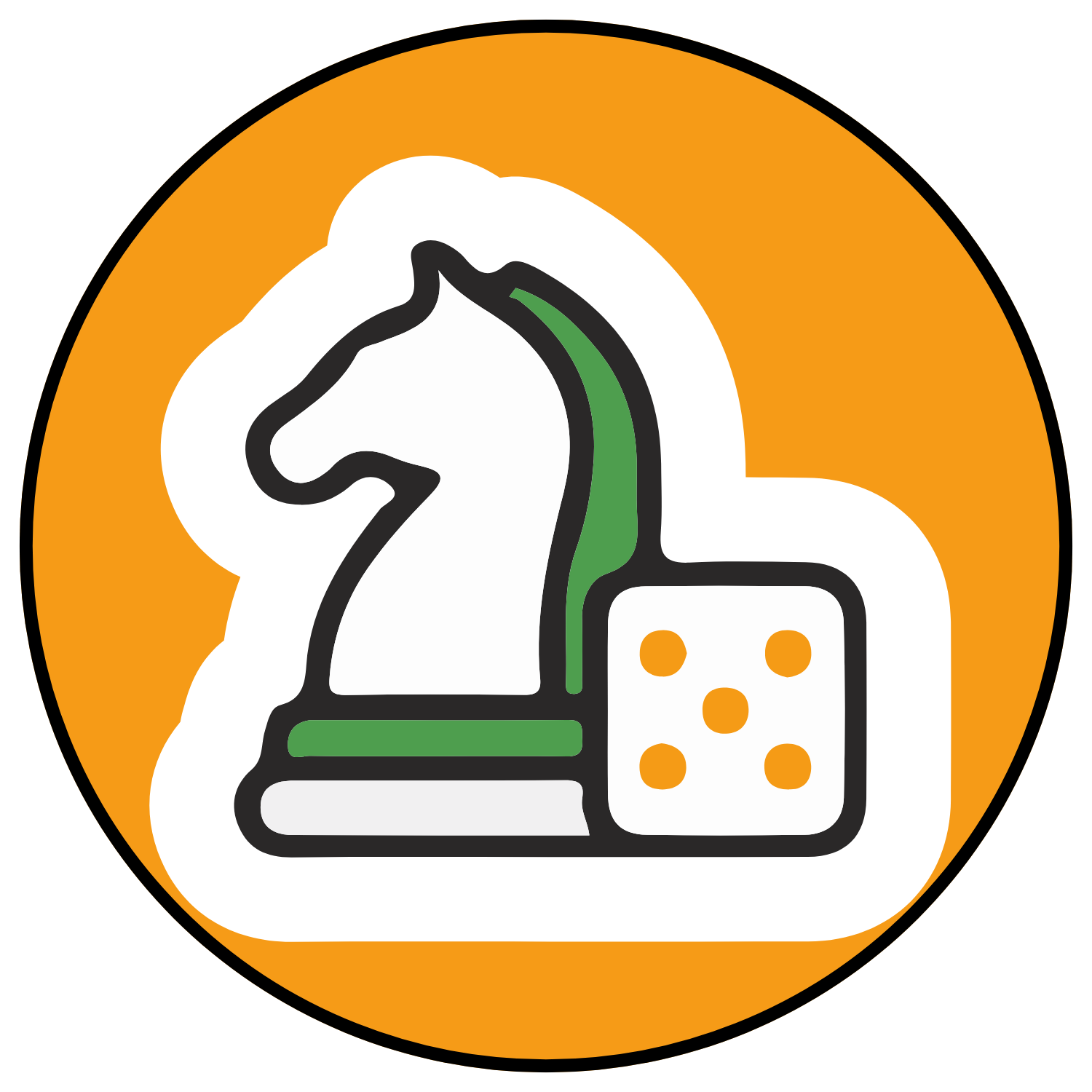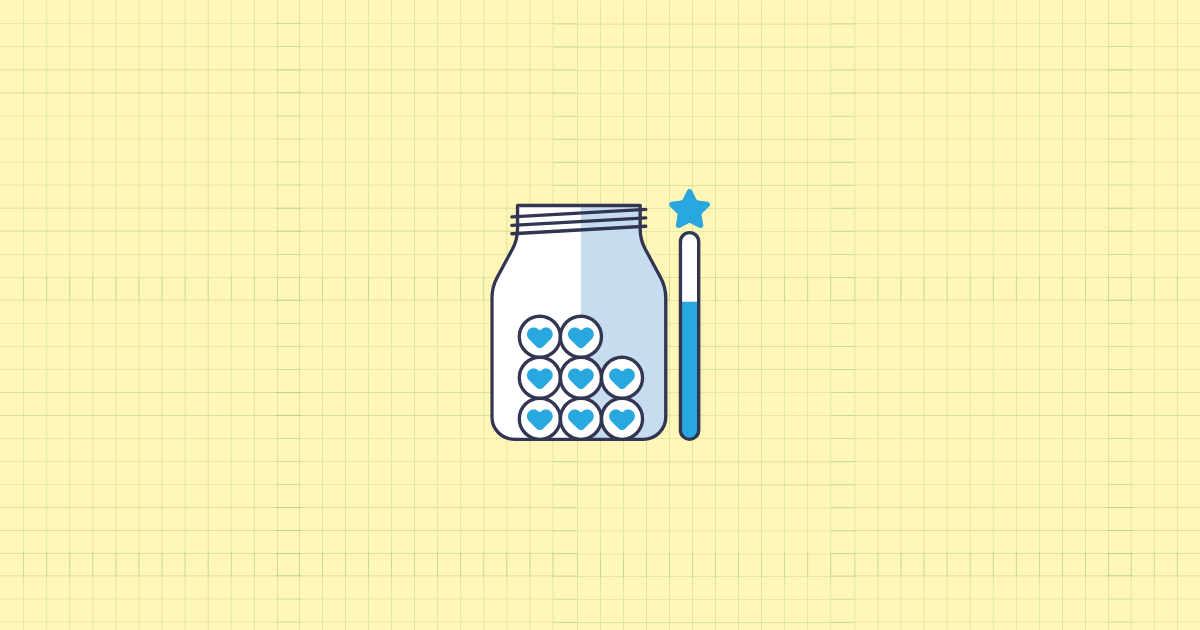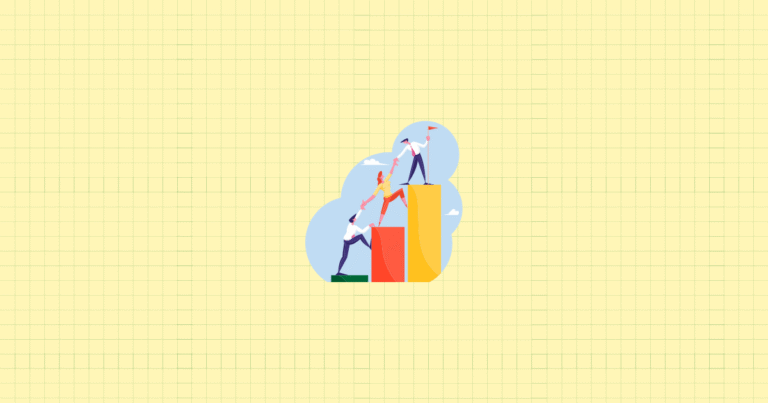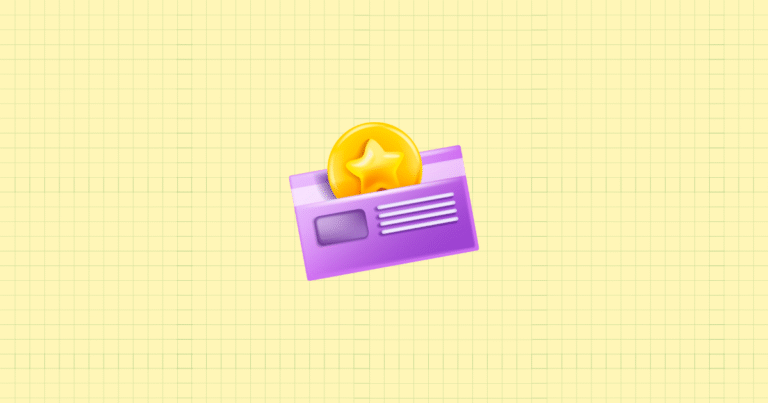Understanding Tiered Loyalty Programs for Shopify Stores
Ever noticed how your favorite coffee shop rewards you with free drinks after you’ve spent a certain amount? Or how airlines upgrade their frequent flyers to first class? That’s the magic of tiered loyalty programs at work. And if you’re running a Shopify store without one, you’re leaving serious money on the table.
Think about it. Some customers visit once, while others return again and again. Shouldn’t these loyal fans get something special for their continued support? A tiered loyalty program doesn’t just reward customers—it transforms casual shoppers into passionate brand advocates who spend more and shop more frequently.
In this guide, you’ll discover exactly how to create a tiered loyalty program that turns your regular customers into VIPs. You’ll learn how to structure your tiers, what benefits to offer at each level, and how to implement everything seamlessly in your Shopify store. Best of all, you’ll see real examples of stores that have used these programs to dramatically increase their revenue and customer retention.
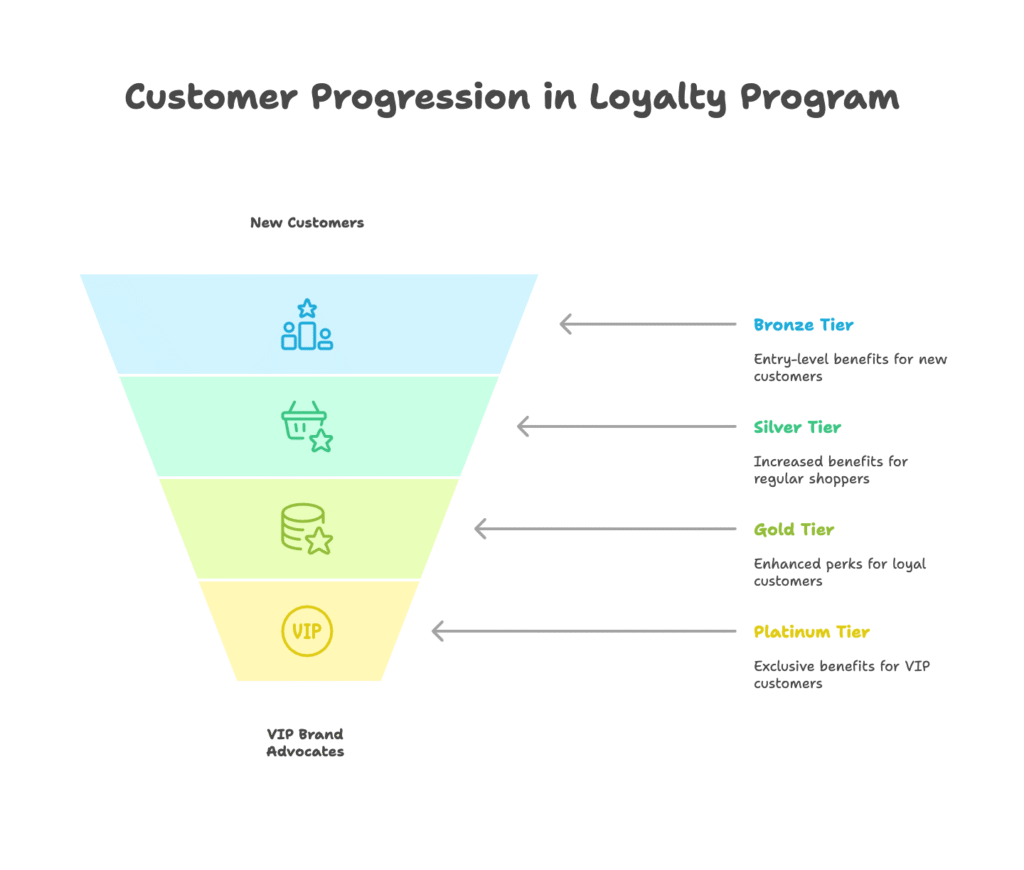
Ready to build a loyalty machine that keeps customers coming back for more? Let’s dive in.
What Are Tiered Loyalty Programs?
At their core, tiered loyalty programs are structured reward systems that offer increasingly valuable benefits as customers move up through different membership levels. Unlike traditional “one-size-fits-all” loyalty programs, tiered systems create distinct levels—typically three to four—with progressively better perks based on customer spending or engagement.
Think of it as creating a VIP hierarchy within your customer base. New customers might start at a Bronze tier, then progress to Silver, Gold, and ultimately Platinum as they demonstrate greater loyalty through purchases or other valuable actions. Each step up unlocks new, more exclusive benefits that aren’t available to customers in lower tiers.
This strategic approach serves a critical purpose for Shopify store owners. It creates a clear pathway for customer progression and engagement with your brand. Instead of a flat loyalty program where everyone gets the same rewards (yawn), tiered programs give customers something to aspire to—a reason to increase their spending or engagement to reach that coveted next level.
The beauty lies in how these programs help you stand out in competitive markets. While other stores might offer a basic 10% discount to all loyalty members, your store rewards top-tier customers with exclusive early access to products, personal shopping assistants, or members-only events. The difference is striking—and customers notice.
The VIP Customer Profile for Shopify Stores
Not all customers are created equal—and that’s a good thing. Your VIP customers are the lifeblood of your Shopify business, often generating a disproportionate amount of your revenue while requiring less marketing spend to retain.
But who exactly qualifies as a VIP customer? They typically fall into three categories:
- Customers with high average order values (AOV) who consistently make larger purchases
- Consistent shoppers who buy from you regularly, even if their individual orders aren’t huge
- Brand loyalists who choose your products over competitors, even when alternatives might be cheaper or more convenient
These golden customers don’t just spend more—they fundamentally change your business dynamics. Research consistently shows that the top 10% of your customers can generate up to 40% of your revenue. They’re also more likely to provide high-quality referrals, essentially becoming free marketing channels that bring in new customers who trust their recommendations.
Perhaps most valuably, VIP customers serve as authentic brand advocates within their networks. They post about your products on social media, leave glowing reviews, and genuinely believe in what you’re selling. This organic advocacy is something money simply can’t buy.
The challenge? Most Shopify stores treat these invaluable customers exactly the same as one-time buyers—a missed opportunity that tiered loyalty programs directly address.
Benefits of Implementing Tiered Loyalty Programs
When you implement a tiered loyalty program, you’re not just creating a nice perk for customers—you’re making a strategic business move that delivers measurable returns. Let’s look at both the hard numbers and the customer experience benefits you can expect.
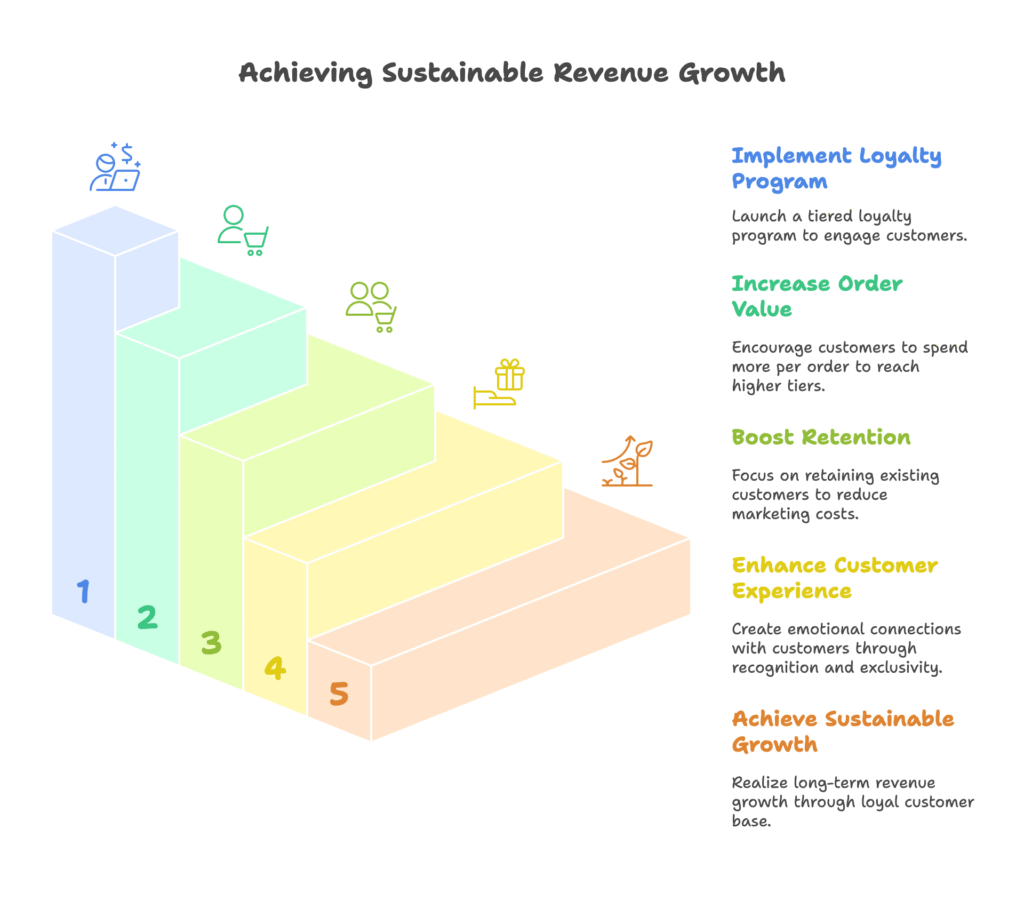
Quantifiable Business Advantages
The data doesn’t lie: loyalty programs drive serious growth. Companies with strong loyalty initiatives grow revenue 2.5 times faster than their competitors. Why? Because these programs create a virtuous cycle of repeat purchases from engaged members who progress through tiers.
Take The Pulse Boutique, a successful Shopify clothing store. After implementing their tiered “Pulse Perks” program, they saw a remarkable 19% increase in average order value. Customers weren’t just buying more frequently—they were spending more per order to reach higher tiers and unlock better rewards.
Customer retention tells an even more compelling story. The Pulse Boutique experienced a 39% increase in returning customers after launching their tiered program. This matters because acquiring a new customer costs five to seven times more than retaining an existing one. By shifting focus to keeping customers rather than constantly chasing new ones, tiered programs dramatically reduce marketing costs while boosting revenue.
The math is simple but powerful: higher retention + increased average order values = sustainable revenue growth without proportionally increasing acquisition costs.
Customer Experience Benefits
Numbers aside, tiered loyalty programs transform how customers experience your brand. They create ongoing engagement that extends beyond the transaction. Rather than visiting your store only when they need something, customers have reason to check in regularly—to track their progress, see new tier-exclusive products, or redeem rewards.
The motivational psychology behind tiers is particularly effective. When customers see they’re just $50 away from reaching Gold status (and all its exclusive perks), they’re much more likely to make that additional purchase. This “goal gradient effect”—where people accelerate their efforts as they approach a reward threshold—creates natural purchase momentum.
Perhaps most importantly, tiered programs satisfy the universal human desire for recognition and exclusivity. We all want to feel special, to belong to the inner circle. When your Silver tier customers see that Gold members get early access to new collections, they’re motivated not just by the practical benefit but by the status it represents.
This sense of belonging creates emotional connections that transcend transactional relationships. Customers no longer shop with you just because your products are good—they shop with you because they feel valued and recognized as individuals. That emotional bond is extraordinarily difficult for competitors to break, even with aggressive discounting.
Designing Your Tiered Program Structure
Creating an effective tier structure is both art and science. Too few tiers won’t create enough motivation to progress; too many become confusing. Let’s explore how to find the perfect balance for your Shopify store.
Determining Optimal Tier Structure
How many tiers should your program have? The answer depends on three key factors: your store size, customer diversity, and management capacity.
For most Shopify stores, a three-tier system strikes the ideal balance between simplicity and differentiation. This typically includes an entry-level tier that’s easy to join, a middle tier for engaged customers, and a premium tier for your most valuable VIPs. This structure is intuitive for customers to understand and manageable for merchants to administer.
Larger stores with diverse customer segments might benefit from a four-tier approach. This allows for more nuanced customer segmentation and creates additional progression milestones to keep customers engaged longer. The drawback? More complexity in management and potentially confusing communication.
For new or smaller Shopify stores, a simplified two-tier structure often works best initially. This might include a basic membership tier for all customers and a VIP tier for your top spenders. As your program matures and your customer base grows, you can always expand to a more sophisticated structure.
When making this decision, also consider industry standards. Analyze what competitors are offering, but don’t just copy them—look for opportunities to differentiate. If every competitor has a three-tier program, perhaps your four-tier approach with unique benefits could be a competitive advantage.
Choosing Tier Advancement Mechanics
Once you’ve decided on the number of tiers, you need to determine how customers will advance through them. There are three main approaches:
Spend-Based Tier Structures
The most straightforward approach ties tier advancement directly to customer spending. For example, ALDO CREW’s program uses clear spending thresholds: customers start at the entry tier (CREW), advance to CREW PLUS after spending $150, and reach CREW VIP after spending $300.
When setting these thresholds, analyze your customer purchase data carefully. What’s the average annual spend of your top 5%, 10%, and 25% of customers? These figures can help you set realistic yet aspirational thresholds for each tier. A common mistake is setting thresholds too high, creating a program where very few customers ever reach top tiers—or too low, devaluing the exclusivity of higher levels.
Remember to consider whether your thresholds reset. ALDO uses a 12-month qualification period, meaning customers must maintain their spending level each year to keep their tier status. This creates ongoing purchase motivation rather than a one-time push to reach a permanent status.
Points-Based Tier Structures
Points-based systems offer more flexibility by awarding points for various actions beyond purchases. Customers might earn 10 points per dollar spent, but also collect points for writing reviews, sharing on social media, or referring friends.
The key to success here is creating balanced point-earning opportunities that align with your business goals. If customer reviews are crucial for your products, award generous points for this action. If you’re trying to build social presence, emphasize points for social sharing.
When designing your points system, ensure the math makes sense. If reaching your Silver tier requires 1,000 points, how many dollars would a customer typically need to spend to achieve this? Is it reasonable? Are there enough non-purchase point-earning opportunities to make progress meaningful?
Hybrid Advancement Models
Many successful Shopify stores combine spending and engagement metrics in hybrid models. For example, The Pulse Boutique allows customers to progress through tiers by accumulating points from various activities—purchases, account creation, social follows, and product reviews.
This multi-faceted approach creates multiple advancement paths for different customer types. Some might progress primarily through high-volume purchasing, while others advance through consistent engagement and advocacy. This inclusivity recognizes that value comes in different forms—a customer who makes smaller purchases but generates five referrals might be just as valuable as a big spender.
Whichever model you choose, the advancement mechanics should be transparent and intuitive for customers to understand. Nothing kills program engagement faster than confusion about how to reach the next level.
Crafting Compelling Benefits for Each Tier
The heart of any tiered loyalty program is what customers get at each level. The benefits need to be valuable enough to motivate tier advancement while remaining profitable for your business. Let’s examine how to create compelling rewards that work at each tier.
Entry-Level Tier Benefits
Your entry-level tier serves as the gateway to your loyalty program. The benefits here should be easy to attain but valuable enough to demonstrate the program’s worth.
Foundational Reward Structures
Begin with basic points-earning opportunities on purchases—perhaps 1 point per dollar spent. These points can accumulate toward rewards or discounts. Simple member-exclusive deals, like “members-only” sales or small discounts (5-10%) on select items, provide immediate value without significantly impacting margins.
Seasonal promotions or birthday rewards add a personal touch with minimal cost. A special offer during a customer’s birth month creates a delightful surprise that encourages engagement at least once annually. These moments of recognition help establish the emotional foundation of loyalty.
Engagement-Building Features
Welcome bonuses kick things off with immediate gratification. Offering 100 bonus points or a small discount on the first purchase after joining creates instant value and demonstrates the program’s benefits.
Early rewards should be easily achievable to build momentum. Consider a “quick win” reward that customers can earn after a single purchase or simple action. This creates a positive first experience and motivates continued engagement.
Most importantly, entry-level communication should clearly showcase the more valuable benefits awaiting at higher tiers. Transparency about what comes next—”Gold members receive free shipping on all orders!”—creates aspiration and clear advancement goals.
Middle Tier Enhancements
The middle tier is where you significantly enhance value to reward continued loyalty and motivate progression to the top tier.
Increased Value Propositions
Boost point earning rates compared to the entry tier—perhaps 1.5x or 2x points per dollar spent. This accelerated earning creates a noticeable difference that customers can feel with each purchase.
Exclusive access to special sales or promotions before they’re available to entry-tier members creates both practical value and status. “Silver members shop our seasonal sale 24 hours before everyone else” combines tangible savings with the emotional benefit of exclusivity.
More personalized shopping experiences can begin at this tier. Perhaps middle-tier members receive personalized product recommendations based on their purchase history, or priority customer service through a dedicated email address.
Connection-Building Benefits
Early access to new product launches turns middle-tier members into insiders who get to experience new items before the general public. This not only creates excitement but also drives sales during crucial new product launch periods.
Specialized customer service options, like faster response times or access to more experienced support staff, show these customers they’re valued beyond the average shopper.
Milestone achievements can further boost engagement. Rewarding customers who have been members for six months with a special gift or bonus points acknowledges their ongoing loyalty and encourages continued participation.
Top-Tier Exclusive Benefits
Your highest tier should offer truly premium benefits that make the status aspirational and rewarding for your most valuable customers.
Premium Reward Offerings
The highest point earning multipliers—perhaps 3x or 4x standard rates—create substantial rewards acceleration. Top-tier members should feel their loyalty is handsomely rewarded with each purchase.
Significant discounts (15-20%) or occasional free products demonstrate tangible appreciation for their ongoing business. Some Shopify stores offer quarterly “VIP gifts” with purchases over a certain threshold, creating regular touchpoints that reinforce the relationship.
Complimentary shipping on all orders, regardless of cart value, removes a common purchase barrier. This not only increases conversion rates but also encourages more frequent smaller purchases that might not otherwise qualify for free shipping thresholds.
VIP Experiences and Recognition
Personal shopping assistants or concierge service create white-glove experiences that truly distinguish top-tier members. This might include personal styling advice, product customization options, or priority fulfillment during busy seasons.
Invitation to exclusive events—whether virtual or in-person—creates community and connection. These might include pre-launch parties for new collections, Q&A sessions with your brand founder, or early access to limited-edition collaborations.
Custom gifts or personalized communications make VIPs feel truly special. A handwritten thank you note from the founder or a gift selected based on their purchase history shows attention to detail that mass retailers simply can’t match.
A particularly powerful top-tier benefit is the ability to share perks with friends or family. ALDO CREW VIP members can extend their free shipping benefit to a friend, creating both goodwill and potential new customer acquisition.
Throughout all tiers, the key is creating a meaningful progression of value. Each tier should offer notably better benefits than the one below it, creating clear motivation for customers to advance.
Implementing Your Program on Shopify
Having designed your tiers and benefits, it’s time to bring your loyalty program to life on your Shopify store. Implementation involves both technical setup and strategic communication to ensure a successful launch.
Technology Selection and Setup
Shopify offers several approaches to implementing tiered loyalty programs, from native functionality to specialized third-party apps.
Shopify Native Options
At the most basic level, Shopify’s customer accounts can track purchase history to manually assign customers to loyalty tiers. This approach works for smaller stores just starting out but quickly becomes unwieldy as your customer base grows.
Shopify Plus merchants can leverage Shopify Scripts to implement tiered pricing automatically. Scripts can identify customer tags indicating tier status and apply appropriate discounts during checkout. While powerful, this requires development resources and offers limited functionality beyond pricing adjustments.
Customer tags provide a flexible way to designate tier membership across any Shopify store. Tagging customers as “Bronze,” “Silver,” or “Gold” allows you to filter marketing communications and manually apply benefits. The downside? Much of the benefit application requires manual intervention rather than automation.
Third-Party App Integration
For most Shopify merchants, specialized loyalty apps provide the most comprehensive solution. Popular options like LoyaltyLion, Smile.io, and Growave offer out-of-the-box tiered loyalty functionality with minimal technical setup.
When comparing apps, consider key features like tier customization, points system flexibility, customer-facing interface quality, and integration with your other marketing tools. Some apps excel at beautiful customer dashboards, while others offer superior analytics or email integration.
Implementation timelines vary by app but typically range from a few hours to several days, depending on your program’s complexity. Most apps guide you through the setup process with best practices built in, significantly reducing the technical burden on your team.
Data Integration Considerations
Whichever approach you choose, several integration points deserve special attention. First, ensure your solution can sync customer purchase history with loyalty tiers. Can the system automatically track spending and upgrade customers when they reach thresholds? Historical data import is particularly important for properly placing existing customers in the right starting tiers.
Points systems should connect seamlessly with your Shopify checkout to award points automatically for purchases. Manual point assignment creates friction that reduces program effectiveness and increases workload.
Finally, consider the cross-platform experience. If you sell through multiple channels beyond your Shopify store—perhaps Instagram shopping or in-person retail—can your loyalty solution track and reward purchases across all channels? A truly seamless program recognizes customer spending regardless of where it happens.
Program Launch Strategy
Even the best-designed loyalty program will fall flat without effective communication and customer onboarding.
Effective Communication Approaches
Start with a dedicated landing page that clearly explains your program structure, benefits at each tier, and how customers can join and advance. Use visual elements like tier comparison charts to make the value proposition immediately apparent.
Email campaigns should announce the program to your existing customer base with personalized messaging. Segment these communications based on customer value—your top spenders might receive different messaging highlighting the VIP tier they’ll immediately qualify for.
In-store messaging includes program promotion on your homepage, product pages, and checkout. Subtle tier indicators throughout the shopping experience (like showing Silver tier members what Gold benefits they’re missing) create advancement motivation at key decision points.
Onboarding Existing Customers
Retroactive tier placement is crucial for a successful launch. Analyze your customer database to place existing customers in appropriate tiers based on their historical spending or engagement. This prevents the frustration of loyal customers having to “start from scratch” to earn status they deserve based on past support.
Special launch promotions can drive immediate engagement. Consider offering double points for the first month, a tier upgrade for customers who join within the first week, or a special founder’s tier for your earliest supporters.
Clear communication about benefits and advancement ensures customers understand exactly what they’re receiving and how to get more. Whether through tooltips in your customer account area, dedicated emails explaining tier benefits, or how-to videos, education drives engagement with your program from day one.
Measuring Success and Optimizing Performance
Once your tiered loyalty program is live, continuous measurement and optimization are essential to maximize its impact on your business results. Let’s explore how to track program performance and make data-driven improvements.
Key Performance Indicators
Effective measurement starts with identifying the right metrics to track.
Essential Metrics to Track
Tier advancement rates and distribution tell you how customers are moving through your program. What percentage of customers advance from Bronze to Silver within three months? Six months? Are certain tiers over or under-populated? These patterns reveal whether your tier thresholds are appropriately set.
Changes in purchase frequency by tier level show the program’s impact on buying behavior. Are Gold tier members shopping 2.5 times more frequently than non-members? Has Silver tier purchase frequency increased since program launch? These comparisons validate the program’s effectiveness in driving repeat business.
Revenue attributed to loyalty program members measures direct program impact. What percentage of your total sales comes from program members versus non-members? How does this compare to pre-program metrics? These figures help calculate your program’s ROI.
Customer lifetime value changes post-implementation provide the most comprehensive measure of program success. Has predicted lifetime value increased across all tiers? Has churn decreased? These longer-term metrics reveal the program’s strategic impact beyond immediate sales lifts.
Data Collection Strategies
Shopify analytics provides baseline data on purchase behavior that can be segmented by customer tags or loyalty tier membership. Regular exports of this data allow for trend analysis over time.
App-specific reporting features typically offer more loyalty-focused metrics, like points earned versus redeemed, reward redemption rates, and tier distribution changes. These specialized insights complement Shopify’s general analytics.
Custom reports for executive stakeholders should distill complex data into clear business impact. Whether monthly or quarterly, these reports should focus on the metrics that matter most to your specific business—usually revenue impact, customer retention improvements, and program ROI.
Program Optimization Techniques
No loyalty program is perfect at launch. Continuous refinement based on real customer behavior is essential for long-term success.
Testing and Refinement Methods
A/B testing different tier thresholds can reveal optimal advancement points. For example, you might test whether a Gold tier threshold of $500 versus $750 annual spend creates better advancement rates without diluting the tier’s exclusivity.
Experimenting with benefit offerings helps identify what truly motivates your customers. Perhaps free shipping drives more advancement than additional points, or early access to new products outperforms larger discounts. Testing different benefits while measuring advancement rates reveals these preferences.
Adjusting tier names and branding elements can significantly impact perception. Names like “Insider,” “VIP,” and “Elite” evoke different emotional responses than “Bronze,” “Silver,” and “Gold.” Testing different naming conventions can reveal which resonates best with your specific customer base.
Addressing Common Challenges
Tier advancement plateaus occur when customers reach a certain tier but stop progressing. This often indicates a benefit gap that fails to motivate further spending. Adding compelling mid-tier benefits or creating limited-time tier promotion opportunities can break through these plateaus.
Managing reward redemption rates is crucial for program economics. Too low, and customers aren’t engaged; too high, and program costs could spiral. Balance can be achieved by adjusting point values, introducing more experiential (lower-cost) rewards, or creating timed promotion periods for redemption.
Preventing program fatigue over time requires ongoing refreshes. Consider quarterly benefit rotations, surprise limited-time perks, or special anniversary rewards that renew excitement even for long-term members. The most successful programs continuously evolve to maintain customer interest.
Successful Tiered Loyalty Program Case Studies
Learning from real-world success stories can provide valuable inspiration for your own loyalty program. Let’s examine two Shopify stores that have implemented exceptional tiered loyalty initiatives.
The Pulse Boutique (Shopify Store)
Program Structure and Implementation
The Pulse Boutique, a women’s fashion retailer on Shopify, created “Pulse Perks,” a three-tier loyalty program that cleverly balances transactional and engagement rewards. Their program demonstrates how even smaller retailers can create sophisticated loyalty experiences.
What makes their approach unique is their multi-faceted earning system. Customers earn points through various actions: account creation, product purchases, social media follows, and product reviews. This diverse point-earning structure acknowledges that customer value extends beyond just purchases.
The Pulse Boutique also emphasized community building within their loyalty framework. Their program encourages social sharing and user-generated content, creating a virtuous cycle where loyalty members become brand advocates who attract new customers.
Performance Results
The results speak for themselves. The Pulse Boutique generated over $200,000 in earned reward purchases—sales directly attributable to their loyalty program. This represents substantial revenue that might otherwise have gone to competitors.
Even more impressively, they achieved a 39% increase in returning customers after implementing Pulse Perks. In an industry where customer acquisition costs continue to rise, this retention improvement dramatically enhances profitability.
The 19% increase in average order value further demonstrates how tiered programs drive larger purchases. When customers see they’re close to earning a reward or advancing to the next tier, they’re motivated to add more items to their cart—a win-win for both the customer and the retailer.
ALDO CREW (Footwear Retailer on Shopify)
Program Framework
ALDO, a global footwear brand with a strong Shopify presence, created “ALDO CREW,” a three-tier structure that exemplifies clear advancement pathways. The program includes CREW (entry-level), CREW PLUS ($150 annual spend threshold), and CREW VIP ($300 annual spend threshold).
What’s notable about ALDO’s approach is their 12-month qualification period for tier status. This creates a rolling evaluation window that keeps customers engaged year-round rather than allowing them to reach a status once and maintain it indefinitely.
The program’s structure is remarkably transparent and easy to understand—spend $150 to reach CREW PLUS, $300 to reach CREW VIP—removing any confusion about advancement requirements. This clarity encourages focused spending toward specific tier goals.
Distinctive Benefits
ALDO creates compelling tier differentiation through progressive discounts. While entry-level CREW members receive 5% off purchases, CREW PLUS members get 10%, and CREW VIP members enjoy 15% off. This clear progression makes the value of advancement immediately apparent.
Free shipping thresholds also decrease by tier—standard shipping rules for CREW, free shipping on orders over $75 for CREW PLUS, and free shipping on all orders for CREW VIP. This benefit directly addresses a major purchase barrier and creates substantial value for frequent shoppers.
Birthday gifts and VIP-exclusive perks add emotional connection to the program. CREW VIP members receive special birthday offers and exclusive access to limited-edition styles, creating moments of delight throughout the year.
Perhaps most innovatively, ALDO allows benefit sharing for top-tier members. CREW VIP members can extend their free shipping benefit to a friend, creating both goodwill and potential new customer acquisition through trusted referrals.
Future Trends and Strategic Recommendations
The loyalty program landscape continues to evolve rapidly. Understanding emerging trends and applying strategic implementation approaches will keep your program ahead of the curve.
Emerging Trends in Shopify Loyalty Programs
Increased Personalization Technologies
AI-driven tier placement and benefit recommendations represent the cutting edge of loyalty personalization. Rather than offering the same benefits to everyone in a tier, advanced programs are beginning to use AI to recommend specific rewards based on individual purchase history and browsing behavior.
Predictive analytics for tier advancement timing helps merchants proactively engage customers who are close to reaching the next level. Imagine automatically sending an email that says, “You’re just $25 away from reaching Gold status!” precisely when a customer is most likely to respond positively.
Hyper-personalized rewards based on browsing behavior take relevance to new heights. If a customer frequently views a specific product category but rarely purchases from it, offering tier-specific incentives for those exact products can break through hesitation barriers.
Enhanced Omnichannel Integration
Seamless tier recognition across online and offline channels is becoming essential as Shopify merchants expand to multi-channel selling. Advanced programs ensure customers receive their tier benefits whether shopping on your website, through Instagram, or in a physical pop-up shop.
Mobile app integration for tier status and benefits extends the program’s presence into customers’ daily lives. Push notifications about tier status, available rewards, or expiring points create touchpoints between purchases that maintain program awareness.
Social commerce connections to loyalty program tiers allow customers to shop directly through social platforms while still earning and redeeming tier benefits. This frictionless integration meets customers where they already spend their time online.
Strategic Implementation Recommendations
Starting Points for Different Store Types
New Shopify stores should begin with a simplified two-tier structure—perhaps “Member” and “VIP”—focusing on basic benefits that create immediate value without overwhelming operational capacity. A 6-12 month rollout timeline allows for gathering customer data before expanding to more sophisticated structures.
Established stores with existing customer bases should develop a transition strategy that properly places current customers into appropriate tiers based on historical spending. Special attention should be paid to communicating with top customers about their immediate VIP status to prevent any perception of “starting over.”
High-volume Shopify stores can implement advanced features like personalized tier recommendations, custom mobile experiences, and sophisticated omnichannel recognition. Their larger customer bases justify the investment in premium loyalty apps and potentially custom development for unique program features.
Long-term Program Evolution Strategy
Scheduled tier structure reviews every 6-12 months ensure your program remains optimized as your business grows. Regular analysis of tier distribution, advancement rates, and reward redemption patterns reveals opportunities for structural improvements.
Seasonal tier promotions and limited-time opportunities create periodic excitement that prevents program fatigue. Special double-points months, temporary tier advancement opportunities, or exclusive seasonal rewards keep the program dynamic and engaging throughout the year.
Continuous customer feedback integration is perhaps the most important long-term strategy. Regular surveys, focus groups with members at different tiers, and analysis of support interactions related to your loyalty program provide invaluable insights for ongoing refinement.
Remember that a truly successful tiered loyalty program isn’t static—it evolves alongside your business and customer needs. The willingness to continuously improve your program based on data and feedback separates exceptional loyalty initiatives from mediocre ones.
References
- Shopify Blog: “What Is a Loyalty Program? 4 Best Examples (2025)” – https://www.shopify.com/blog/loyalty-program
- Flits Blog: “Complete Guide To Shopify Store VIP Loyalty Programs” – https://blog.getflits.com/shopify-store-vip-loyalty-programs/
- Praella: “Maximizing Success with Shopify Plus Advanced Loyalty Programs” – https://praella.com/blogs/shopify-insights/maximizing-success-with-shopify-plus-advanced-loyalty-programs
Ready to supercharge your Shopify store’s sales with perfectly optimized discount codes and tiered loyalty programs? Growth Suite is a Shopify app that helps you intelligently increase conversions by leveraging customer behavior data to deliver personalized, time-limited offers. It automatically generates unique discount codes, tracks visitor intent, and seamlessly integrates with your store’s design. Install it with a single click and start turning casual browsers into loyal VIP customers today!
